Hierarchical triangulations: Dobkin/Kirpatrick Hierarchies
Resources:
-
O'Rourke (``Computational Geometry in C''), section 7.5
-
D. Dobkin and D. Kirpatrick, ``Fast detection of polyhedral intersections',
Journal of Algorithms, 6, 381-192, 1995.
-
D. Dobkin and D. Kirpatrick, ``Determining the separation of preprocessed
polyhedra -- a unified approach'', ICALP-90, LNCS 443, 400-413, Springer
Verlag, Berlin, 1990.
Why?
-
One problem with all of the other hierarchical space indexing structures
that we have looked at is they do not provide ``easy'' nearest nieghbours.
-
It is an exact structure, unlike the other ``binning'' methods.
Donkin hierarchies exactly capture the bounds of a group of points, unlike
quadtree/octrees/kd trees.
What:
-
Start with a group of points of interest, then create a Delaunay triangulation.
We can make this a constrained triangulation, e.g. we have some segments
or triangles in the world that we are interested in.
-
Now every point is directly connected to all of its nearest neighbours.
-
The triangles formed here form what will be the leaves of a hierarchical
tree.
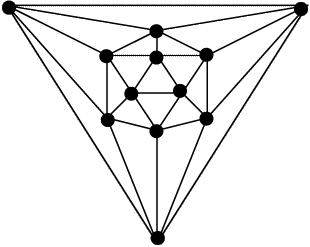
Now remove independent sets of nodes, to build the triangulation at
the next level up in the tree:

The only problem is that the new regions at this level are not neccessarily
valid triangulations, although the previous level was. We must retriangulate:
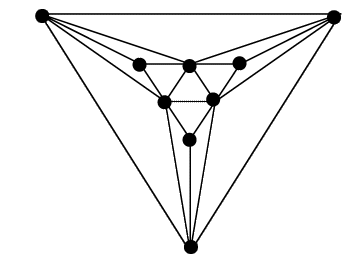
Repeat this node removal and triangulation until there is only one large
triangle at the top. Here is one possible next step for this triangulation, hierarchy, which does not require retriangulation after removing the node:

Linking into a hierarchy
How do we link these levels? Quad/kd trees etc. are straightforward,
because the mapping from a parent region to a child region is one-to-many.
But it is possible, because of the retriangulation step, to make a triangulation
hierarchy so that a child triangle at one level has more than one parent
triangle at the next level whose areas overlap the child's areas.:
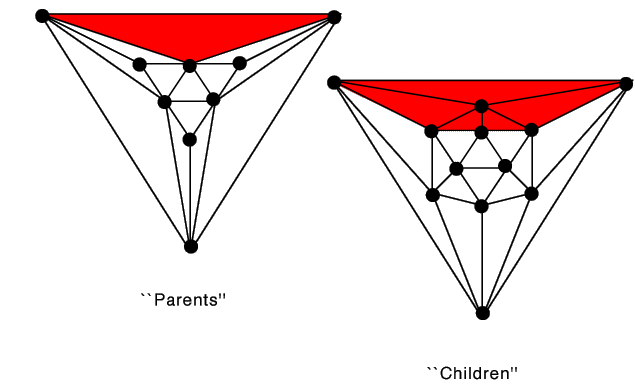 |
Each parent triangle has multiple children triangles in the previous
level of the hierarchy. |
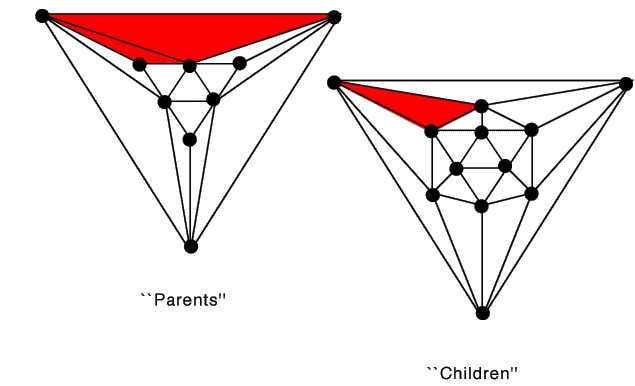 |
At the same time, each child triangle can have multiple parent triangles
-- compare this to quadtrees or kd-trees, where each child has only one
parent. |
We link the levels through the node that was removed. When we
retriangulate the region after removing a node V, connect each new ``parent''
face to that node V whose removal caused the face to be created.
At each level, faces that remain from the last level are simply connected
through to the same face in that level.
For each level, every node is also connected to its adjacent faces.
Thus, since parent nodes are connected to the vertex V whose removal from
the previous level caused the parent to be created, each parent is connected
to a (non-disjoint) set of children triangles via V's adjacency links at
the previous level.
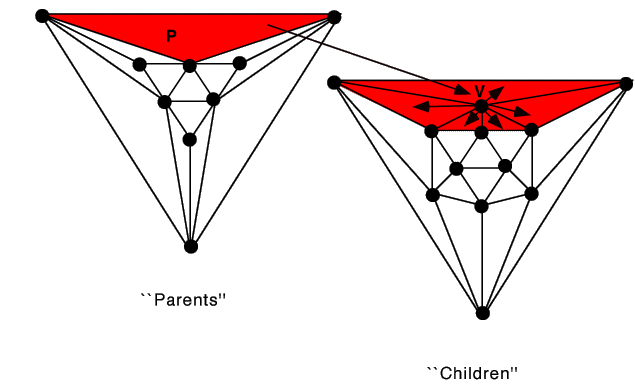
Analysis:
Constructing: It was proved by Edelsbrunner that we can remove
at least n/18 of the vertices when we remove an independent set(if we
pick the right ones to remove!) of vertices from a polytope graph
(e.g. the Delaunay triagulation in 2D or 3D). Thus we are guaranteed
a tree with O(log N) depth. Also, because of the constant fraction
reduction at each step, we can construct the hierarchy in O(N) time
and space.
Uses:
-
Locating points in 2D. Start with the coarsest triangulation
(the ``last'', or top level of the hierarchy). A point will fall
into only one of the children triangles of this top level triangulation;
recurse on that triangle's children until a leaf triangle is encountered.
-
Object collision in 3D. We can represent a convex polyhedron
in 3D with the 3D version of this hierarchy. This can be used for detection
with a plane, for example, or determining the closest point to the plane,
in O(log n) where the polyhedra has n vertices..
-
We start with the simplest level of the hierarchy.
-
Then, we descend the hierarchy, only considering children regions/nodes
in the direction of the plane. In the figure below, the plane we are trying
to intersect with is the plane at the top of the cube. At each step of the descent, we complicate the triangulation by adding more nodes, edges, and faces; but, we only add the extra nodes and faces in the direction that we are interested in.

[Start] [Back]
Douglas
De Couto
decouto@graphics.lcs.mit.edu
Joshua Napoli
napoli@mit.edu
Last modified: Tue Mar 17 09:49:26 1998







